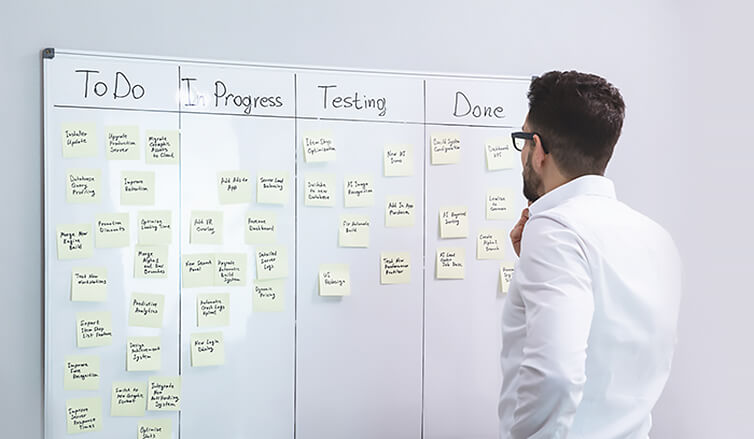
As an independent and objective assessment of business activities, internal auditing gives a ton of priceless information to the management, allowing for unbiased and smart decision-making.
It can be used to:
- Evaluate how efficient your regular operations are and find ways to improve performance,
- Verify that your financial records are reliable and kept in line with current accounting laws,
- Find weak spots in your risk management and corporate governance so that your company is run accountably and stays capable of meeting its strategic goals.
Internal auditing offers plenty of immense benefits and, thus, plays a massive role in promoting companies’ well-being. But to produce those benefits, internal audits must be carried out in an effective way, and agile methodology provides auditors and their clients with a solid basis for doing that.
So, let’s explore what agile auditing is and which advantages it has over a more traditional approach.
What Is Agile?
Agile methods were born in the software development industry at the end of the 20th century. Though they continue to prevail among the IT folks, a growing number of non-IT projects and companies start to embrace agile values too.
Here’s what these values are according to the Agile Manifesto:
“Individuals and interactions over processes and tools.
Working software over comprehensive documentation.
Customer collaboration over contract negotiation.
Responding to change over following a plan.”
In other words, agile methodology is all about flexibility and staying in touch with your clients on an ongoing basis. It prioritizes short-term planning and favors frequent reflections on work progress, which allows you to adapt to changes and mitigate project risks without much pain.
By doing all that, agile methodology empowers you to attain the desired results with maximum efficiency. It lets you ensure the best client experience and increase customer satisfaction in a way that a more traditional management approach can never afford.
Agile Audit vs. Traditional Audit
The traditional auditing process is linear in nature and includes four major phases:
- Planning
- Fieldwork
- Reporting
- Follow-up
It implies that each new audit step begins merely when the previous one is completed.
You first develop a comprehensive long-term project plan and list all the tasks to be done. Next, you proceed to implement that plan, and the outlined course of action is not expected to change in the process – you just follow it until the final report is created and presented to a client.
In contrast, the agile audit process can be illustrated as a cycle. It requires a clear understanding of your long-term audit goals as well. But instead of making you plan every single action in one sit, agile methodology invites you to schedule new tasks every two or three weeks.
Throughout these short-term work periods – aka sprints – your audit team members are encouraged to discuss their ongoing progress during daily standup meetings. You’re also supposed to have regular meetings with clients to keep them informed of your interim findings and achievements. And whenever a sprint is finished, you need to analyze its results and plan the next one considering clients’ feedback, your changing priorities, successes, and failures endured during the past two weeks.
Key Benefits of Agile Auditing
According to a case study by PwC, agile auditing promotes the following benefits:
- Real-time assurance over retrospective assurance | Agile auditing doesn’t just aim to produce a standard audit report at the end of the project. Instead, it allows clients to get regular verbal assurance throughout each sprint. As a result, clients don’t need to wait for months to start improving their internal inefficiencies and faults – the management can make small changes in the company bit by bit, right from the start of the audit process.
- Focus on high-value tasks and improved work efficiency | As per agile principles, you need to evaluate your progress and achievements at the end of each sprint. Thus, audit teams have a better chance of noticing various process inefficiencies and productivity problems than when using a traditional process. Following the agile methods, you can always see whether the tasks you’re working on bring you closer to the set project goals. And if they don’t, you can promptly adjust your course of action every two weeks, always adapting to change and setting the right priorities.
- Superior client experience | Agile methodology implies close interaction between audit teams and their clients – companies’ management. And such a high degree of client involvement adds a lot of value. It removes the risk of misunderstanding between stakeholders and gives companies an opportunity to be really heard by their auditors. Results: clients have a better sense of control over the audit process, and your audit team becomes better informed to enhance the quality of its outputs.
- Outstanding team learning and work effectiveness | Agile is also about the close collaboration between audit team members, which helps drive innovation and boost collective performance quality. Frequent progress discussions increase team morale and improve decision-making. Besides, regular meetings help every auditor stay informed of what’s going on in the team and learn from their colleagues. The latter is particularly important for junior team members – it lets them gain essential competencies and advance in the profession quicker.
How to Make Your Audit Process More Agile
If the above benefits are something you’re eager to gain and you’re ready to give agile auditing a try, here’s what you can do to make it work:
1. Practice short-term planning
Short-term planning allows for rapid problem-solving and establishes a highly responsive audit process, which is key to staying agile and boosting efficiency. Therefore, instead of scheduling each single audit task at the beginning of the project, focus on designing two-week sprints. Each of your sprints should be linked to clear performance objectives and goals. This way, it will be easier to understand if you’re moving in the right direction or not.
2. Conduct regular meetings
Your sprints should include daily 15-minute standup meetings, where your team members will talk about what they’re working on and discuss the encountered issues with colleagues. In addition, you may arrange other regular scrum meetings, i.e., sprint planning and sprint retrospective.
The former is carried out before every new project sprint. It’s perfect for figuring out what you want to attain during the next two weeks and setting new priorities. And as for sprint retrospectives, they are held at the end of sprints to evaluate their success, understand what went wrong, and sum up the achievements.
It’s always a good idea to invite clients to sprint retrospectives. However, if you’re striving for an exceptional level of client involvement, be sure to ask them to attend daily standup meetings too.
3. Visualize your work process
Agile teams love workflow visualization tools, and it’s safe to say that Scrum and Kanban boards are their favorites. Both of these boards are divided into several columns that represent different workflow phases (e.g., in-progress, under review, done). Team members move their tasks to corresponding sections of the board to indicate their current work progress. This allows team leaders to identify process bottlenecks, control collective performance and manage workloads more effectively.
You can utilize either a physical or a digital Kanban board, though the latter is often more advantageous. Digital boards normally come as part of project management software that allows for effortless and largely automated progress monitoring. Besides, they can be accessed from anywhere. So, even if some of your auditors work remotely, they can still use the Kanban board online to review team progress and manage their own.
4. Establish ongoing communication with clients
Even if you’re working for a super-busy client who can’t attend your standups or sprint retrospectives frequently, you still need to find a way to provide them with real-time assurance and hear out their feedback on a regular basis.
To do so, you need to agree on which communication tools you’re going to use to exchange information and stay in touch. Though face-to-face interactions are preferable, even a short daily call can make a huge difference.
5. Track team progress to drive efficiency
High-quality evidence is vital for effective sprint planning. You need to analyze your performance data during sprint retrospectives in order to come up with reasonable solutions for process improvement.
Time tracking is one of the best ways to collect such performance data. You may apply actiTIME to track the use of time in your team, see how your auditors comply with their task estimates and whether they manage to complete all the assigned tasks during sprints. Then, you can run one of the multiple actiTIME reports to get a clear picture of each sprint’s time tracking results and find a way to boost productivity and make your audit process more efficient.


















































